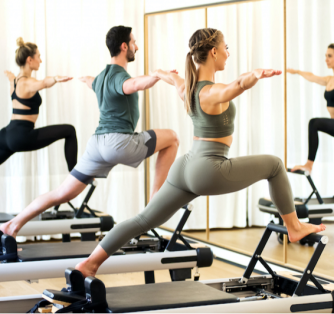Menu
Weight loss
Hormones
Sex
EXPLORE
MEET NU IMAGE MEDICAL
TREATMENTS
MEET NU IMAGE MEDICAL
TREATMENTS
MEET NU IMAGE MEDICAL
How Pilates Can Help If You Sit at Work All Day


Sitting in front of a computer all day is not something that you should do if you want to stay healthy, though most of the jobs require you to sit in place to get your work done. So what should you do? First of all, let’s dive into why sitting all day is bad for your body.
Why Sitting All Day is Bad For Your Body
Below are some of the reasons why you should not sit all day at work
1. Poor Posture: Sitting for long periods of time can cause your back and neck muscles to become weak and your posture to suffer. This can lead to chronic pain and stiffness.
2. Reduced Mobility: Sitting all day can lead to tight hip flexors and weak glutes, making it difficult to move your body freely and easily.
3. Weakened Core: Sitting places your core in a flexed position, which can weaken the muscles that are responsible for stabilizing your spine.
4. Poor Circulation: When you sit all day, blood can pool in your legs and feet, leading to poor circulation.
5. Increased Risk of Injury: Poor posture and lack of mobility can lead to increased risk of injury due to overuse and strain.
6. Weakened Immune System: Prolonged sitting can weaken your immune system by decreasing your body’s natural ability to fight off viruses and bacteria.
Why Pilates?
Pilates is an effective solution for improving posture, core strength and flexibility. It can also help to alleviate pain associated with sitting for long periods of time. Pilates can help improve the body’s overall alignment and balance, which is essential for good posture. It also helps to strengthen the core muscles, which support the spine, and helps to reduce the strain on the back. Additionally, Pilates exercises can help to improve flexibility and range of motion, which is important for being able to sit in an ergonomically correct position. Practicing Pilates regularly can help to create a stronger, more balanced body and improve overall posture.
Pilates exercises you can do at your desk (or next to your desk)
1. Seated Spinal Twist: Sit up straight in your chair and twist your torso to the left. Place your left hand on your right knee and hold for a few seconds. Return to the center, and switch sides.
2. Desk Pushups: Place both hands on the edge of your desk and step back so you’re in a plank position. Bend your elbows to lower your chest towards the desk, then push back up.
3. Chair Swivel: Sit up straight in your chair and place your feet firmly on the floor. Place your hands on the armrests, and twist your torso to the left. Return to the center, and switch sides.
4. Seated Leg Lifts: Sit up straight in your chair and extend your left leg out in front of you. Lift up your leg and hold for a few seconds. Return to the starting position, and switch sides.
5. Desk Reverse Plank: Sit up straight in your chair and place your hands on the edge of your desk. Lift your hips off the chair and hold for a few seconds. Return to the starting position.
Conclusion
Pilates is an excellent way to counteract the effects of sitting at work all day. Pilates helps to improve posture, increase flexibility, build strength, and relieve tension in the body. Pilates also helps to improve circulation and can be beneficial for reducing stress levels. Regular Pilates sessions can help to improve balance and coordination, as well as reduce the risk of injury. Pilates can also be beneficial for those who are starting to experience back pain from sitting in the same position for too long. Pilates can help to strengthen and lengthen the muscles in the back, hips, and abdomen, while improving posture and alignment. Finally, Pilates can help to improve concentration and focus, which can be beneficial for those who spend a lot of time sitting at work.
This article is for informational purposes only and does not constitute medical advice. The information contained herein is not a substitute for and should never be relied upon for professional medical advice. Always talk to your physician about the risks and benefits of any treatment. Nu Image Medical may not offer the medications or services mentioned in this article.
